Create boost and bury rules
Learn how to create a boost rule that improves the ranking of specific items in results
Available for Search, Browse, Campaigns, Collections, Facet pages, and Recommendations.
With boost and bury rules, merchandisers can influence the ranking of certain items on results pages. Boost and bury rules are configured similarly; however, their impact on results differs.
- Boost: Applying a boost rule to an item or attribute will increase the ranking of the affected items in the results set.
- Bury: Applying a bury rule to an item or attribute will decrease the ranking of the affected items in the results set.
How it works
Every item on the results page of a search query and the results of a browse page has an item attractiveness score. This score is determined by Constructor’s ranking algorithm. Boost lets you increase this score, whereas bury helps you reduce this score.
To do this, Constructor takes every item score in the result set and determines the standard deviation. Standard deviations are unique to the result sets of each search query and browsing experience. Generally, standard deviations are relatively low result sets that consist of similar items, however, it increases in diverse ones. This is due to the proximity between the item scores.
When boosting or burying items or by item attribute, merchandisers can take a percentage of 40x the results set’s standard deviation and add that amount to a boosted or buried item’s current score.
Let’s look at two examples.
How boosting works
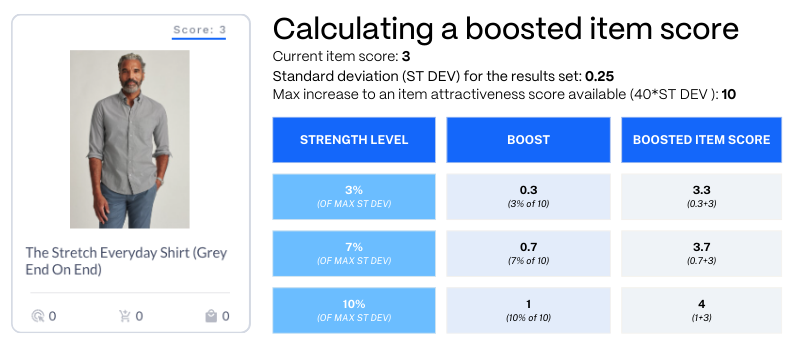
In the above example, the calculated standard deviation for the result set is 0.25. This means a merchandiser can take a percentage of 40x that deviation (10) and add that to an item’s score.
Constructor provides quick access percentages (3%, 7%, and 10%) which, using this example, would allow a merchandiser to boost an item’s score by 0.3, 0.7, and 1, respectively. This would bring the example item’s score from 3 to 3.3 (3%), 3.7 (7%), and 4 (10%). There is also a quick access 30% boost available via a rocket ship button. In this example, it would add 3 to the item’s score, bringing it to 6.
For merchants looking for a greater boost, an Extra power slider is available to boost items or item attributes by up to 100%. For this example, this would boost an item by that maximum increase of 10, making the final item score for this shirt 13. This allows merchandisers to truly move an item or group of items up in the rankings.
A note on extra power strength levelsChoosing a boost or bury strength level 30% or greater will significantly override ranking by Constructor’s algorithm, other rules your team created, and can remove top-selling or most-clicked items from the top of the results.
How burying works
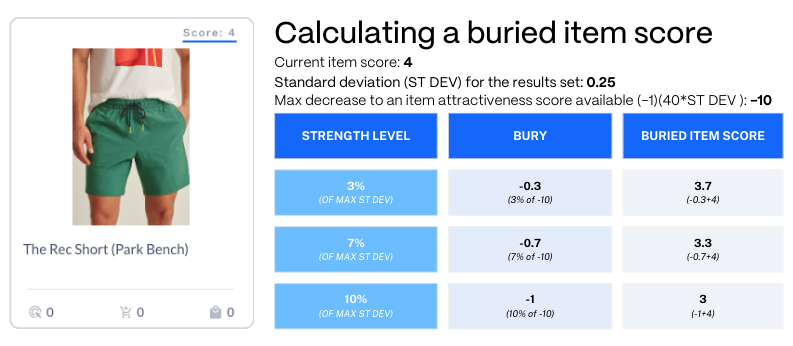
In the above example, the calculated standard deviation for the result set is 0.25. This means a merchandiser can take a percentage of -40x that deviation (-10) and add that to an item’s score.
Constructor provides quick access percentages (3%, 7%, and 10%) which, using this example, would allow a merchandiser to bury an item’s score by -0.3, -0.7, and -1, respectively. This would bring the example item’s score from 4 to 3.7 (3%), 3.3 (7%), and 3 (10%).
For merchants looking for a greater bury, an Extra power slider is available to bury items or item attributes by up to 100%. For this example, this would bury an item by that maximum decrease of -10, making the final item score for this shirt -6 (but Constructor stops at a score of 0). This allows merchandisers to truly move an item or group of items down in the rankings.
A note on extra power strength levelsChoosing a boost or bury strength level 30% or greater will significantly override ranking by Constructor’s algorithm, other rules your team created, and can remove top-selling or most-clicked items from the top of the results.
How can I use boost and bury rules?
Boost and bury rules can help merchandisers achieve several goals.
- Boost
- Promote new arrivals and ensure they appear within the first 30 results.
- Increase visibility for discounted items that need to sell quickly.
- Boost items from a particular brand to increase their visibility in search results.
- Highlighting items based on time-sensitive relevance, like seasonal products or items relevant during certain times of the day.
- Bury
- De-emphasize inactive or discontinued products, moving them below items from new collections.
- Bury out-of-stock items so they appear towards the end of the search results but are still accessible if needed.
Create a boost or bury rule
Creating a boost or bury rule has three steps: choosing where to apply the rule, choosing the rule type and item(s) or attribute(s), and configuring the rule.
Step 1: Choose the context
Context refers to the results page for which you are creating the rule. For example, Search, Browse Category, Facet, or Collection.
Want to boost or bury items across multiple contexts?You’ll need to create a campaign. Follow steps 1-3 in our campaign article, then jump back here to steps 2-4.
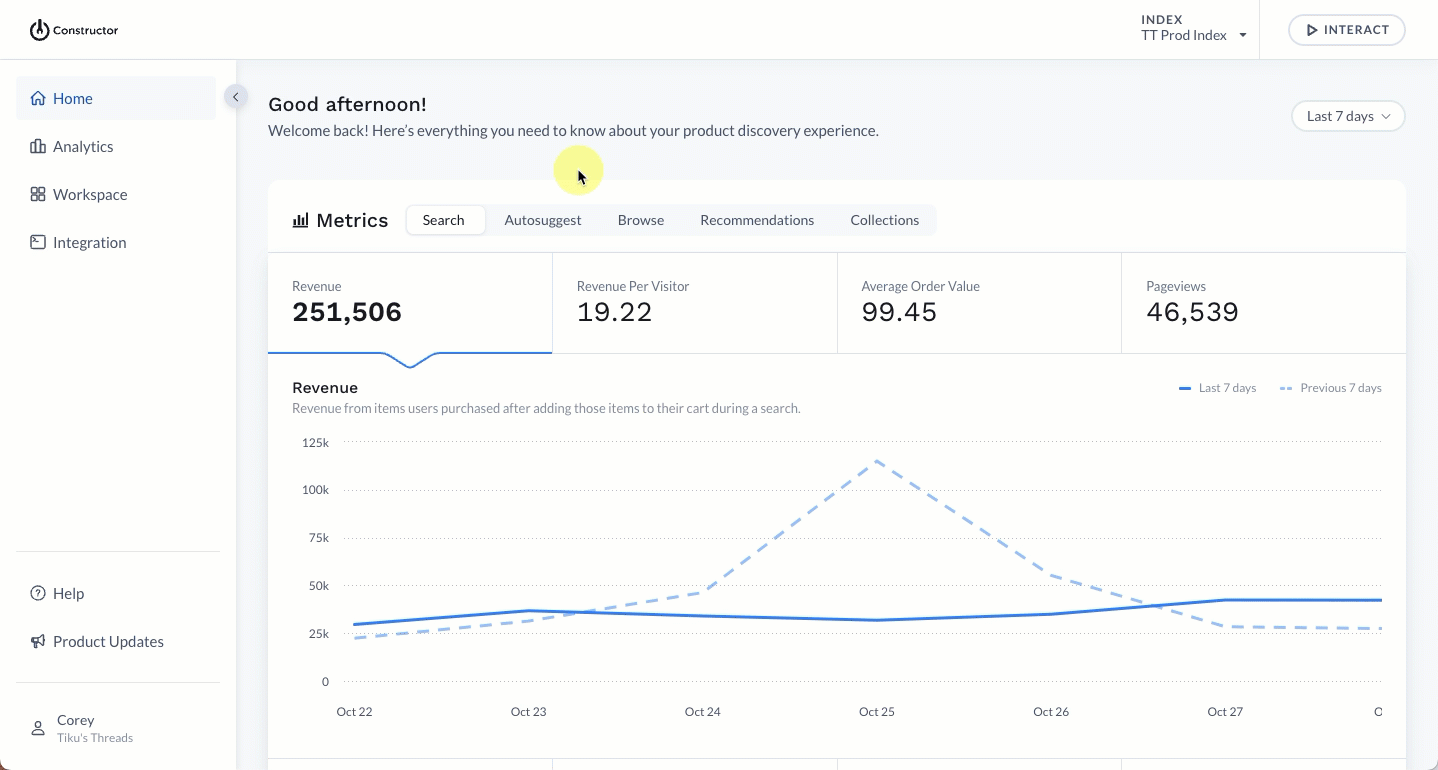
- Select Workspace in the side menu of your Constructor dashboard, then select Searchandising.
- Select + Add New Rule in the top-right corner of the page.
- On the pop-up, choose the context for which you wish to create the rule.
- Search: Allows you to choose a query to create a single rule for Search and Autosuggest.
- Browse: Allows you to choose between creating a rule for Category, Facet, or Collection. You will then be prompted to select the category, facet, or collection.
When would I want to create a global rule?Global rules are ideal for when you wish to create rules that are not limited to specific queries or filters but instead influence an entire search or browse experience.
For example, you could use a global searchandising rule to exclude out-of-stock items from all search results and category pages, ensuring customers only see available products.
Step 2: Choose the rule type and item(s) or attribute(s)
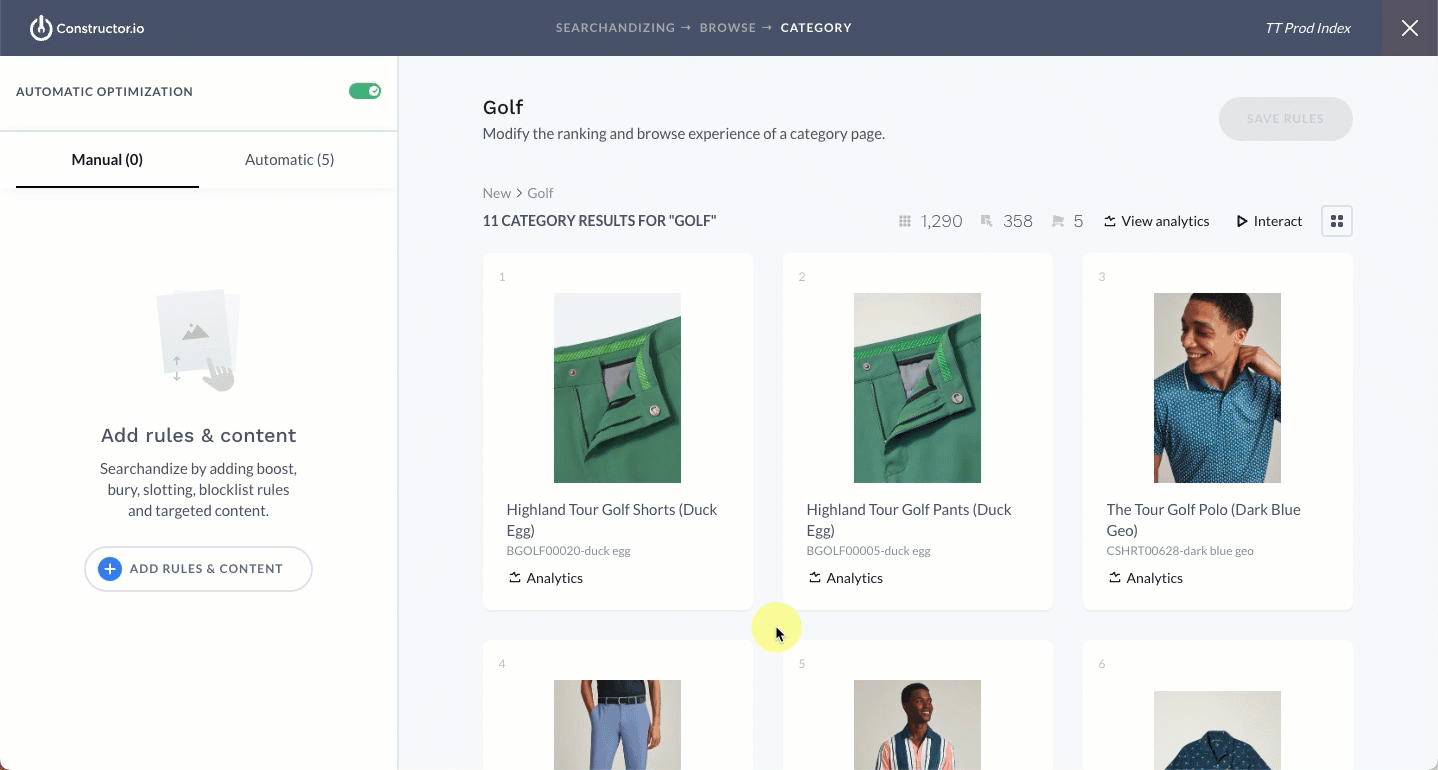
- Select Add Rules & Content on the left side of the page.
- In the Rerank section, select your rule type:
- Boost: Allows you to amplify items in results ranking.
- Bury: Allows you to move items farther down in results ranking.
- Slotting: We do not cover slotting rules in this article.
- Next, choose which item, attribute(s), or metric(s) you wish to boost or bury.
By item
You can boost or bury specific items on the results page of a search query, browse category, collection, and facet.
Select Items to choose the item(s) you wish to boost or bury. You will be prompted to search for item(s). You can do so by item name or ID. Select the checkbox to the left of the name for each item you wish to boost or bury.
Alternatively, you can upload a CSV of items you wish to boost or bury. Select the upload button and choose the file from your device.
By attribute
You can boost or bury items on the results page of a search query, browse category, collection, and facet by a shared attribute, like Category, Brand, or Color.
In the By Attribute section, expand the desired attribute to view available options. Select the checkbox to the left of the attribute you wish to boost or bury.
What is a hidden attribute?In addition to the By Attribute section, you can also select an attribute under By Hidden Attributes.
These are attributes, or facets, not visible to users as filter options but can still be used here, by your team, for searchandising. For example, the hidden attribute
cnstrc_agecould be used to boost new items.Learn more about hidden attributes (facets) here.
By metric
Constructor shares many common metrics with companies, such as cnstrc_age, price, and more. However, companies can define custom metrics they wish to boost and bury by (or to use with other searchandising rules).
Reach out to your CSM for assistance defining custom metrics.
Step 3: Configure the rule
Strength level
You can define a specific boost or bury strength level. Learn more about strength levels here.
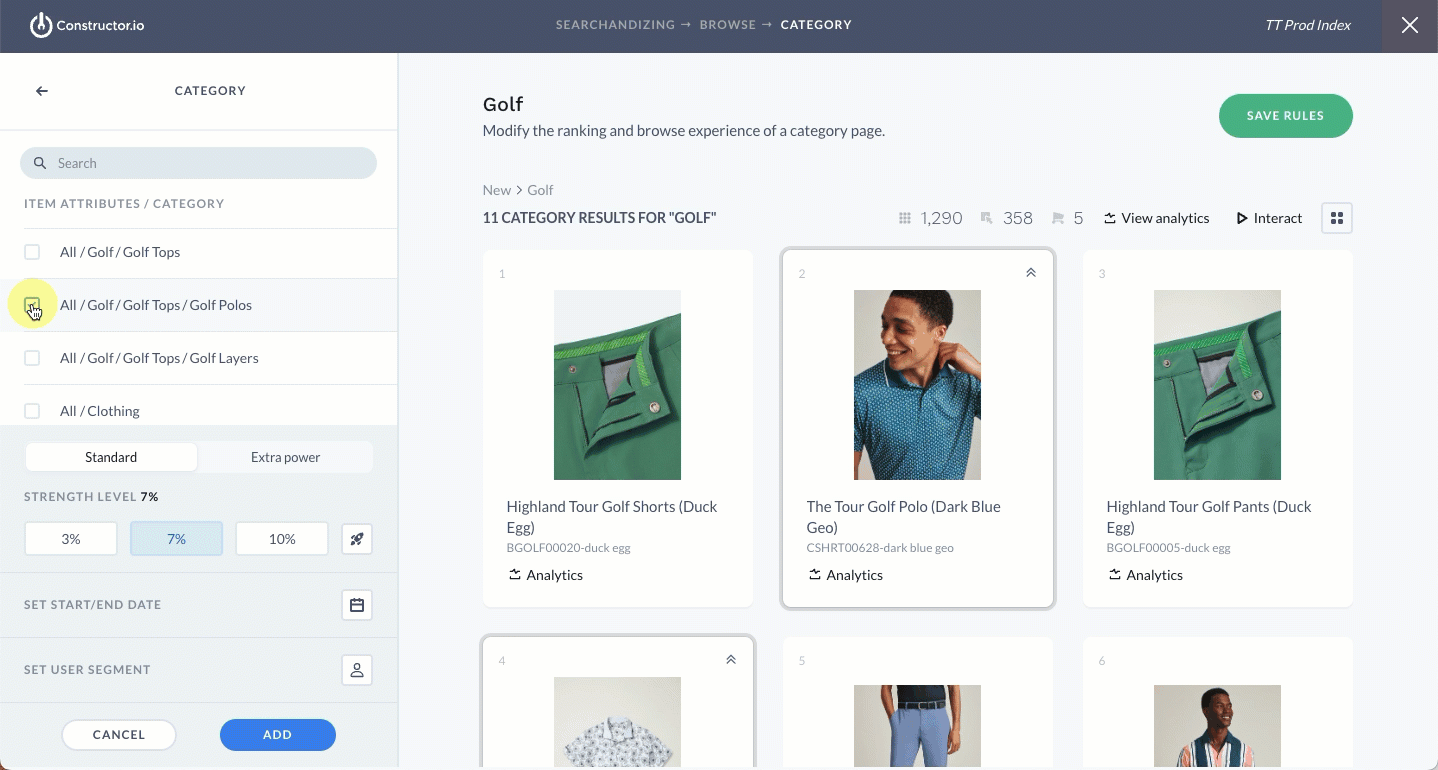
- On the Standard tab, you can boost or bury by the following increments:
- 3% (previously Weak)
- 7% (previously Moderate)
- 10% (previously Strong).
- Rocket. Supercharge the boost to 30%.
- On the Extra power tab, you can define a specific boost or bury percentage using the slider provided (5%-10%).
A note on extra power strength levelsChoosing a boost or bury strength level 30% or greater will significantly override ranking by Constructor’s algorithm, other rules your team created, and can remove top-selling or most-clicked items from the top of the results.
Add a user segment
You can apply the rule to a specific subset of users by selecting a user segment. Available segments are those provided by your company and the geographic information available for users.
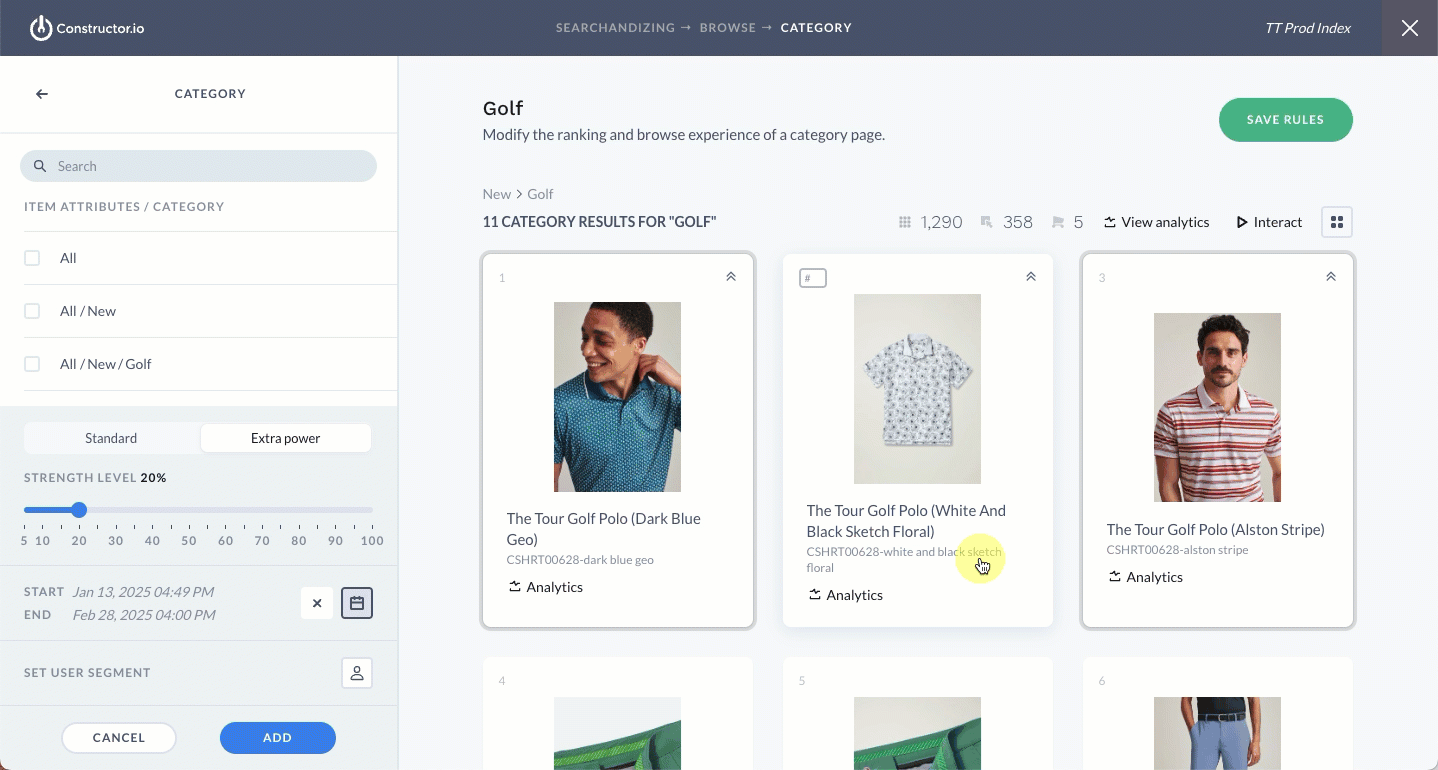
- Select the user icon to launch a pop-up to select the desired segment.
- User segment: Use the drop-down menu to select an existing segment from the list.
- Add new: Select this option to create a new segment. Condition options include Country, State/Region, and City. Select Save in the bottom-right corner to save the new segment.
- Once done, select Apply in the bottom-right corner of the pop-up.
Add a start/end date
You can add a Start Date and End Date to the boost or bury rule, which allows you to time box the rule's impact on returned results. Dates are not required. You can also define a start date without a set end date.
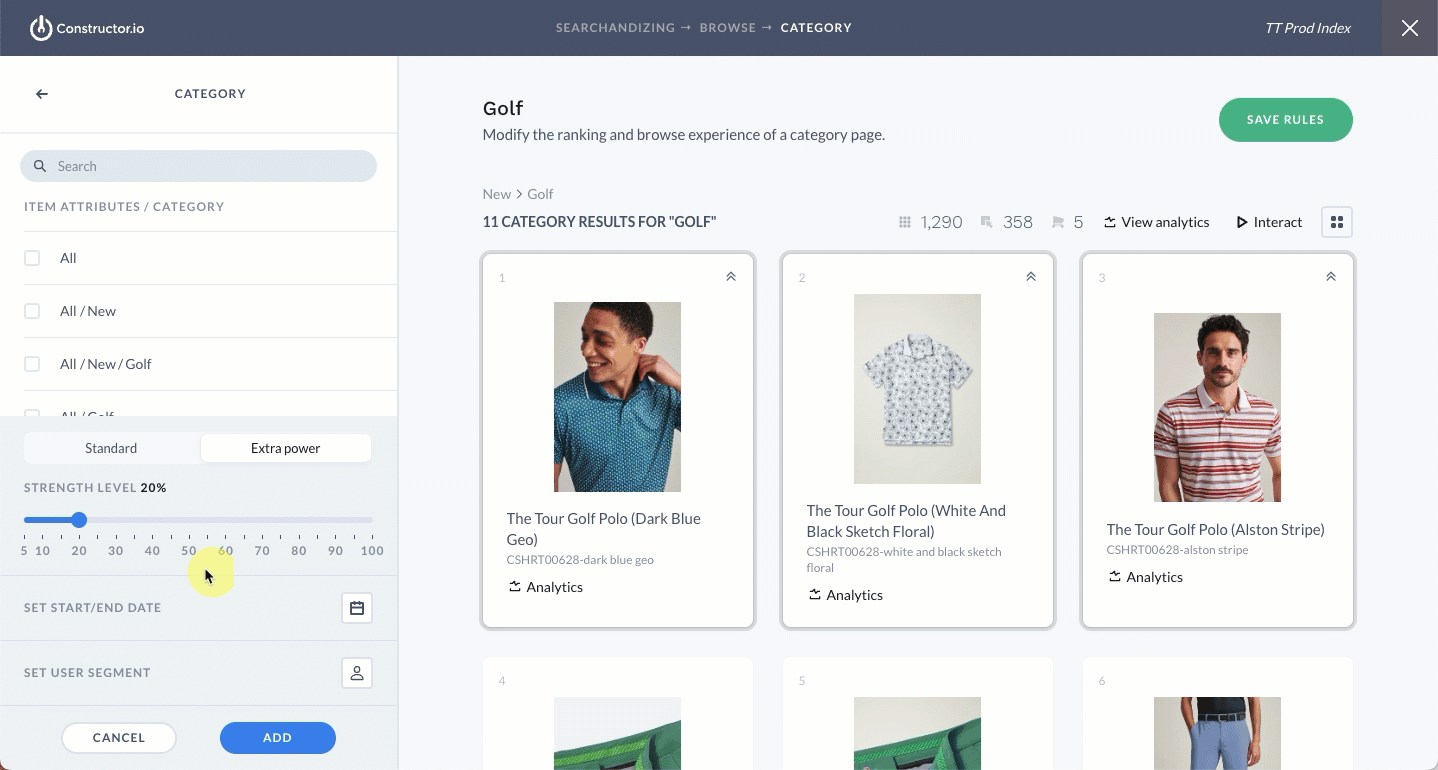
- Select the calendar icon to launch a pop-up where you can define start and end dates and times.
- Dates: Select either Date field to launch a calendar picker, which allows you to choose a specific start and end date.
- Time: Once you define a date, a default start or end time will populate in drop-down fields to the right of the date fields. Use these drop-downs to edit the start and end times (hour, minute, AM/PM). Times are in the time zone displayed beneath the fields.
- Once done, select Apply in the bottom-right corner of the pop-up.
Step 4: Save the rule
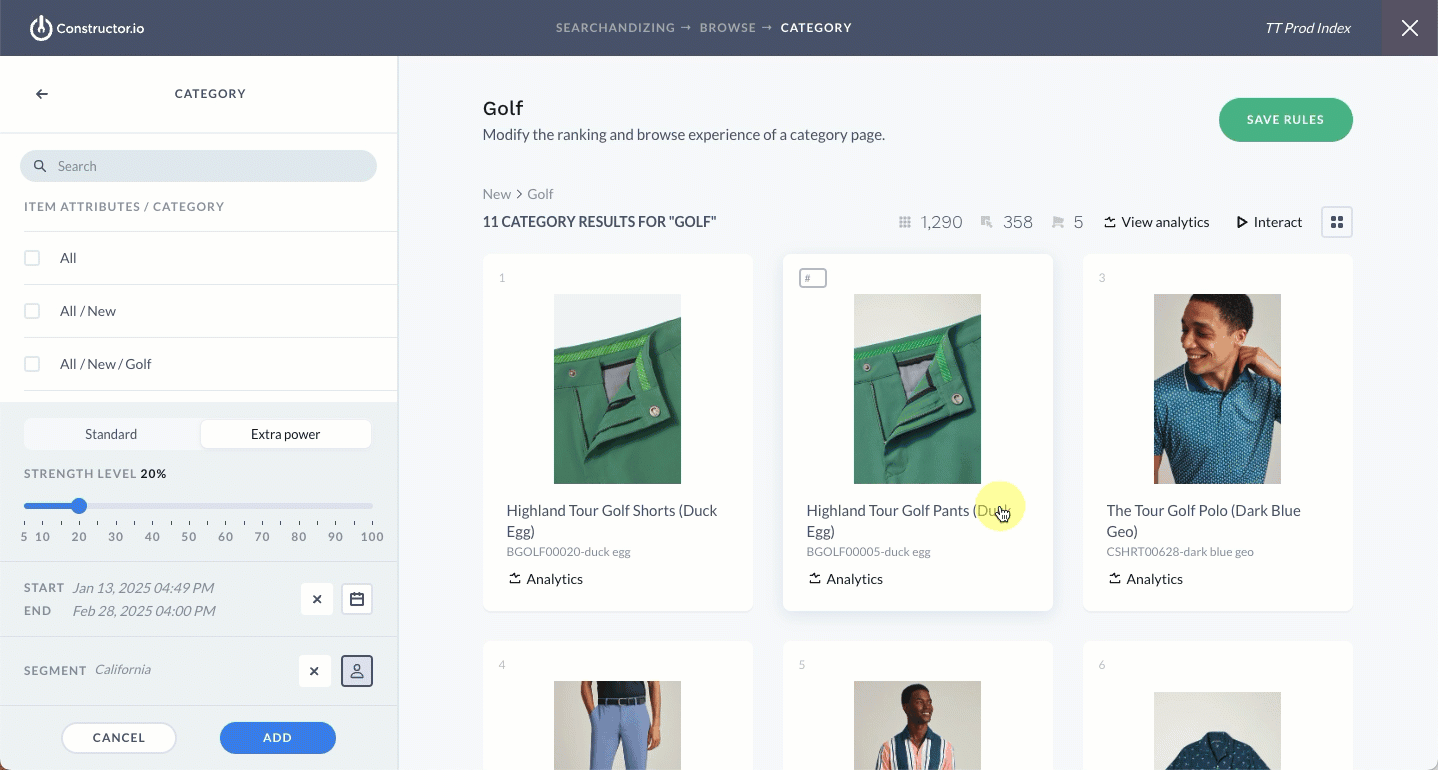
- After defining the Strength Level, Start/End Times, and/or User Segment, select Add in the bottom-right corner of the side menu. This will take you back to the list of all rules and content for the query, category, or facet page.
- Select Save Rules in the top-right corner of the page to save your new rule.
View changes to item positions
Constructor makes it easy to view changes to item positions once you have applied a boost or bury rule. There are two ways to view these changes, both of which we outline below.
View changes on an individual item tile
If an item changes positions due to a boost or bury rule, you will see this change reflected in the top-left corner of the item tile. The original position is listed first, with an arrow indicating its movement to a new position.
For example, in the below example, the Resort Golf Shirt (Blue and Pink Retro Stripe) moved from position 19 to position 3 (19 -> 3).
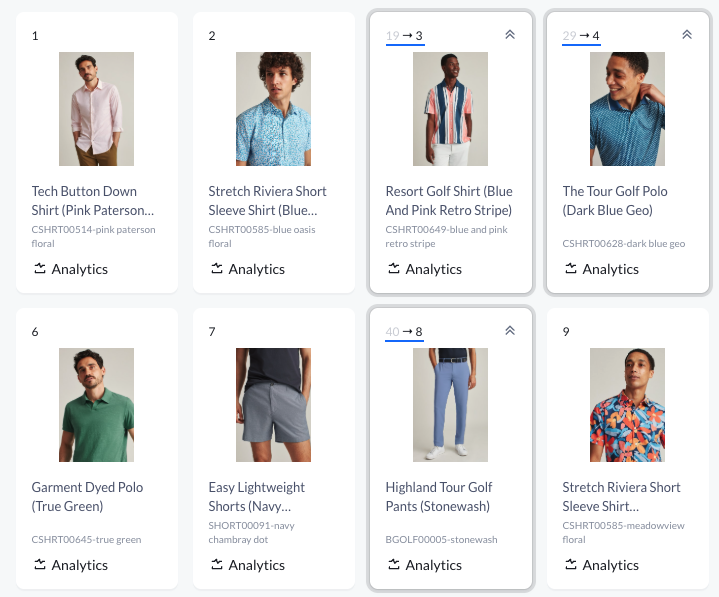
Change in position indicated in the top-left corner of an item tile.
View a summary of changes
If you wish to see a summary or list of all items with changes to their position due to a boost of bury rule, then select View Changes at the top of the page.
This View Changes link also indicates the number of impacted items. For example, View Changes (11) indicates that 11 items experienced a change to their position due to a boost or bury rule.
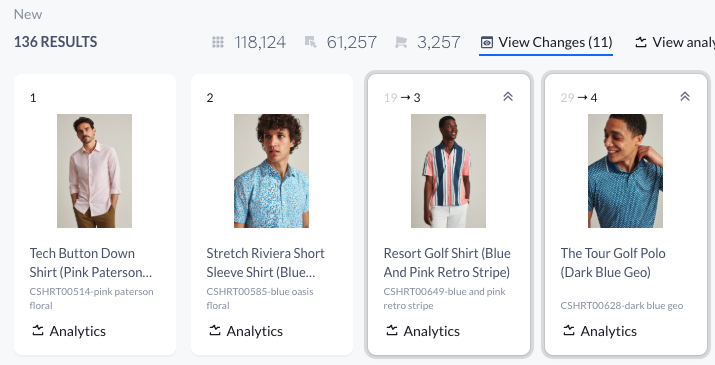
View Changes link indicates the number of items that experienced a position change.
Changes to positions for each item appear to the left of each item. The original position will be listed first, with an arrow indicating its movement to a new position.
For example, in the below example, The Tour Golf Polo (Dark Blue Geo) moved from position 29 to position 4 (29 -> 4).
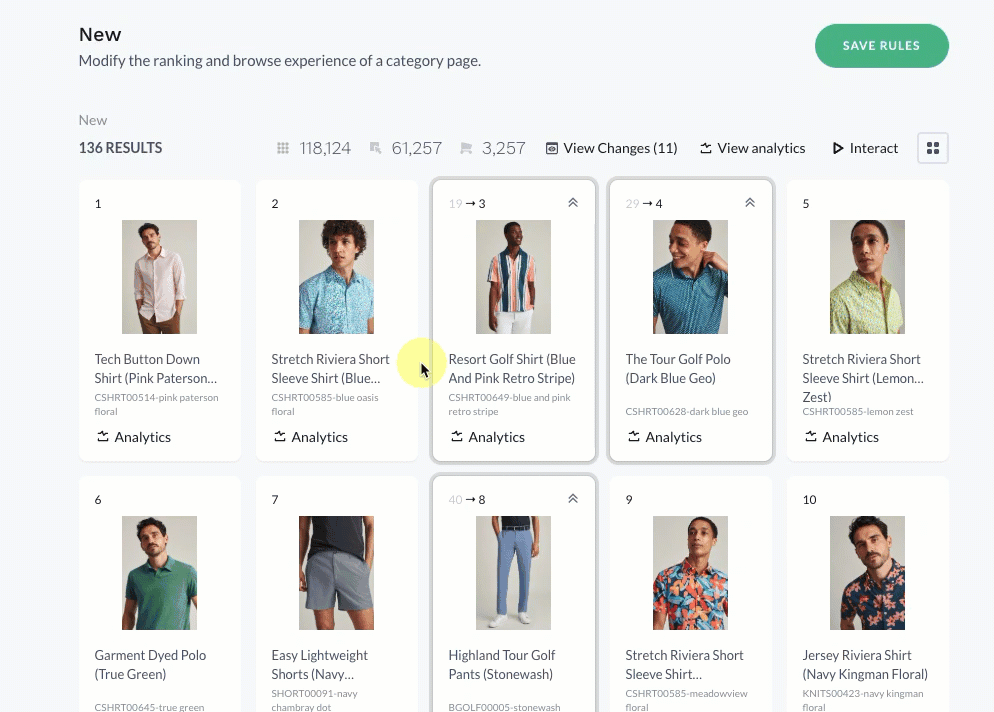
A note about position changes over the 200 results markWhen configuring searchandising rules, Constructor will only display 200 item results. Items may move above or below this threshold, which will be reflected by a 200+ position.
For example, if a buried item moved from position 187 to 211, the position would read 187 -> 200+. For a boosted item that moved from position 204 to 192, the position would read 200+-> 192.
Updated 8 days ago